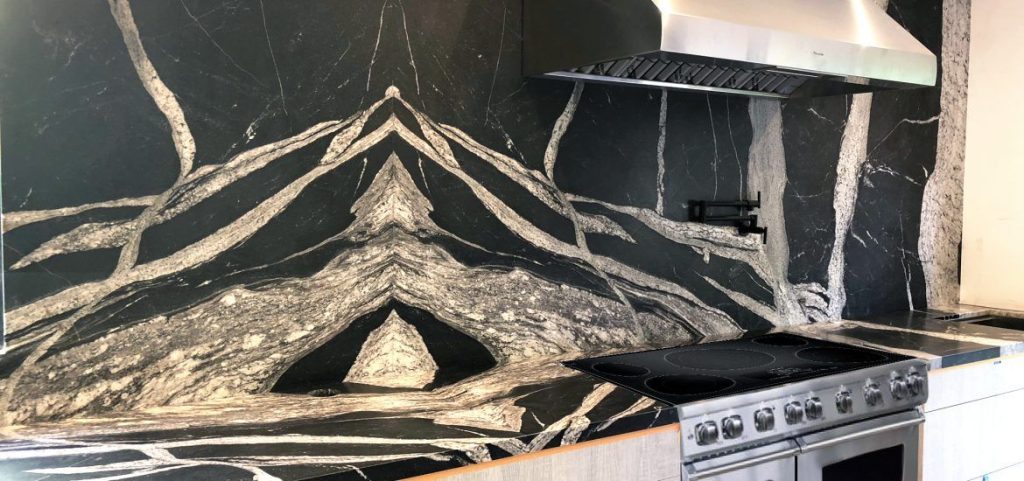What is the best material to use for a kitchen backsplash? When it comes to selecting the ideal material for a kitchen backsplash, natural stones offer a timeless elegance and unmatched durability that can transform your kitchen into a sophisticated and functional space. Each type of natural stone brings its unique characteristics and aesthetic appeal, making it essential to understand the differences and benefits of each to make an informed decision.
Marble
Marble is often regarded as the epitome of luxury in kitchen design. Its smooth, cool surface and distinctive veining create an opulent and classic look that can elevate any kitchen. Marble is available in a variety of colors, from the pristine white of Carrara marble to the dramatic black and gold veins of Nero Marquina. This stone’s natural beauty is unparalleled, and it can serve as a stunning focal point in both traditional and modern kitchens. However, marble is a porous stone and is prone to staining and etching, especially from acidic substances like lemon juice or tomato sauce. Regular sealing and careful maintenance are necessary to preserve its pristine appearance.
Granite
Granite is another popular choice for kitchen backsplashes, known for its incredible durability and wide range of colors and patterns. Unlike marble, granite is highly resistant to scratches, heat, and stains, making it an excellent choice for a busy kitchen environment. The natural speckling and variety of colors in granite can complement any kitchen style, from classic to contemporary. Granite requires less maintenance than marble, though it still benefits from periodic sealing to maintain its resistance to stains.
Quartzite
Quartzite is a natural stone that combines the beauty of marble with the durability of granite, making it an increasingly popular choice for kitchen backsplashes. It comes in a variety of colors and often features striking, marble-like veining, giving it a luxurious look. Quartzite is harder than granite, making it extremely resistant to scratches and heat. This durability, combined with its stunning appearance, makes quartzite a highly desirable option for those seeking both aesthetics and functionality. Like other natural stones, quartzite requires sealing to protect against staining and maintain its luster.
Limestone
Limestone is a natural stone that offers a softer, more rustic look compared to marble and granite. Its subtle, earthy tones and natural texture can add warmth and character to a kitchen. Limestone is less dense than granite or quartzite, making it more susceptible to scratches and stains. It requires regular sealing and careful maintenance to prevent damage from spills and acidic substances. Despite these considerations, limestone can be a beautiful choice for those seeking a more organic, natural aesthetic in their kitchen.
Travertine
Travertine is another natural stone that brings a unique, textured look to kitchen backsplashes. Formed from mineral springs, travertine features a distinctive, porous surface with natural pits and grooves. These features can be filled or left unfilled, depending on the desired look. Travertine’s warm, neutral tones can complement a variety of kitchen styles, from rustic to contemporary. However, its porous nature requires sealing and careful cleaning to prevent stains and damage.
Slate
Slate is a natural stone that offers a distinctive, rugged beauty. Its deep, rich colors range from dark gray and black to greens and purples, making it a striking choice for a kitchen backsplash. Slate is highly durable and resistant to heat and scratches, making it suitable for the kitchen environment. However, its uneven surface can make it more challenging to clean compared to smoother stones. Regular sealing is also necessary to protect slate from staining and maintain its appearance.
Onyx
Onyx is a luxurious and visually striking natural stone that can make a bold statement in any kitchen. Known for its translucent quality and vibrant colors, onyx can be backlit to create a stunning visual effect. However, onyx is softer and more fragile than other natural stones, making it more susceptible to scratches and damage. It requires careful handling and regular maintenance to preserve its beauty. Despite these challenges, the unique and dramatic appearance of onyx can add a touch of opulence and sophistication to a kitchen backsplash.
When choosing a natural stone for a kitchen backsplash, it’s essential to consider not only the aesthetic appeal but also the practical aspects of each material. Marble, granite, quartzite, limestone, travertine, slate, and onyx each offer unique benefits and challenges. Proper maintenance and care are crucial to preserving the beauty and functionality of these natural stones. Regular sealing, careful cleaning, and protection from acidic substances and heavy use will ensure that your natural stone backsplash remains a stunning and durable feature in your kitchen for years to come.
In conclusion, natural stones offer a wide range of options for creating a beautiful and functional kitchen backsplash. From the timeless elegance of marble to the rugged durability of slate, each stone has its own unique characteristics and appeal. By understanding the properties and maintenance requirements of each type of natural stone, homeowners can choose the perfect material to suit their style, needs, and lifestyle, resulting in a kitchen that is both beautiful and practical.

